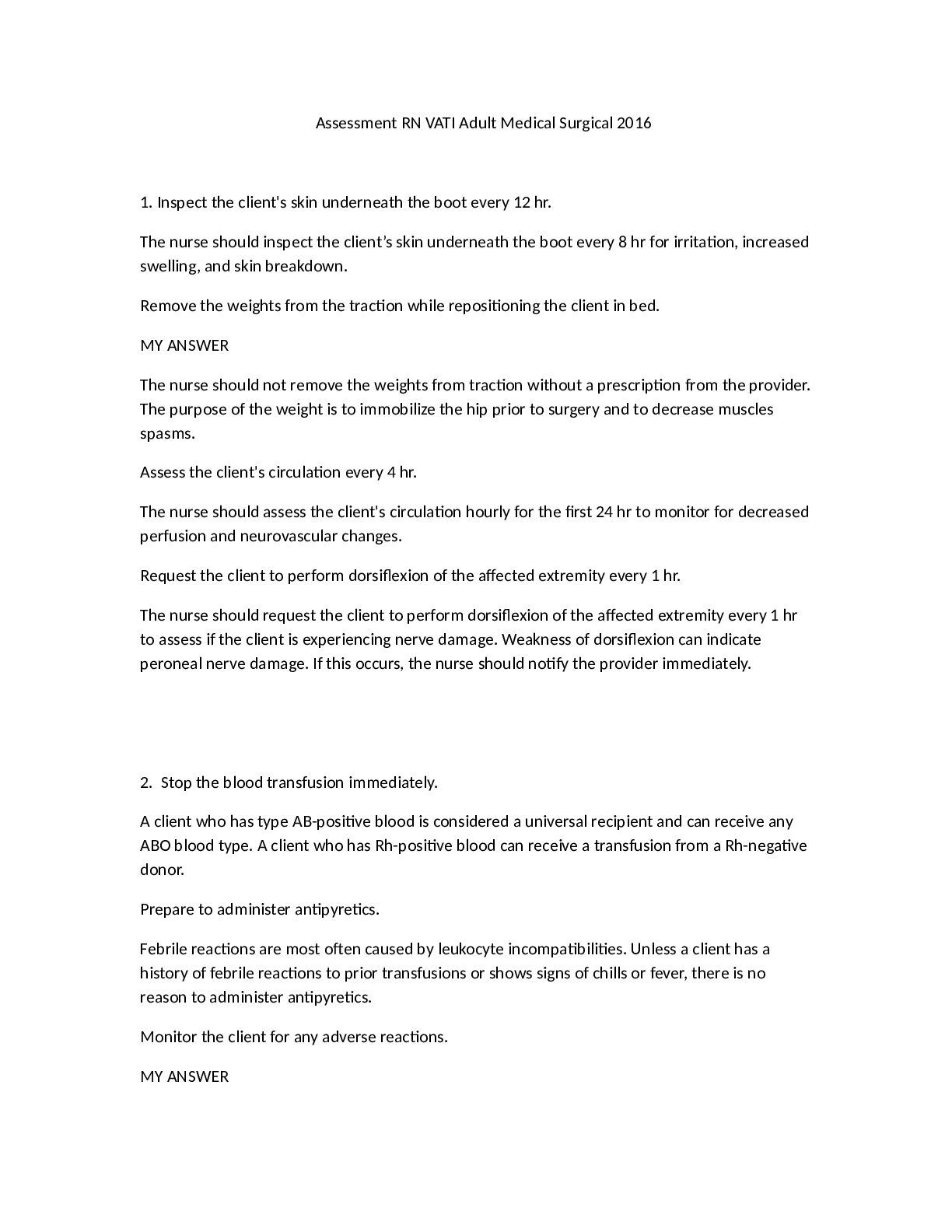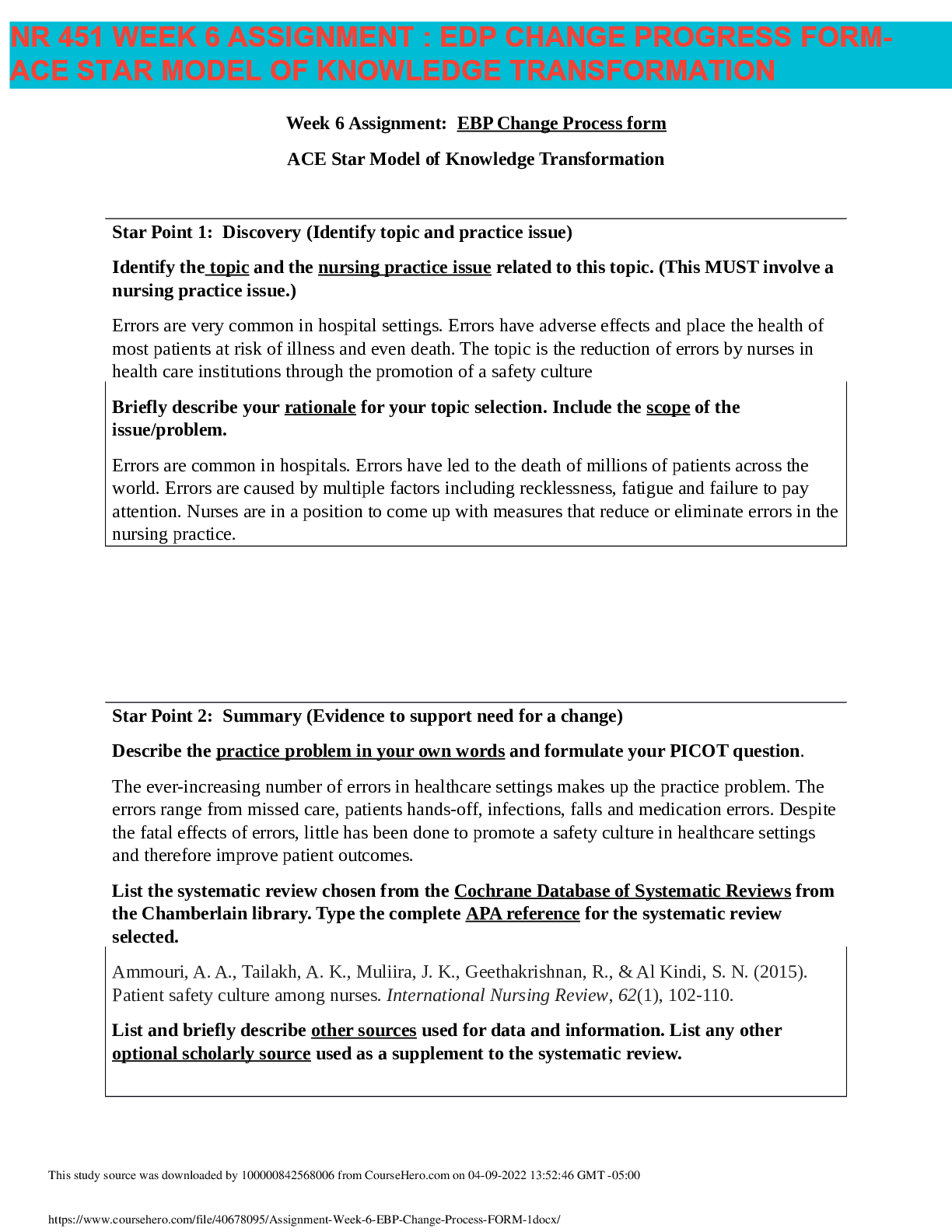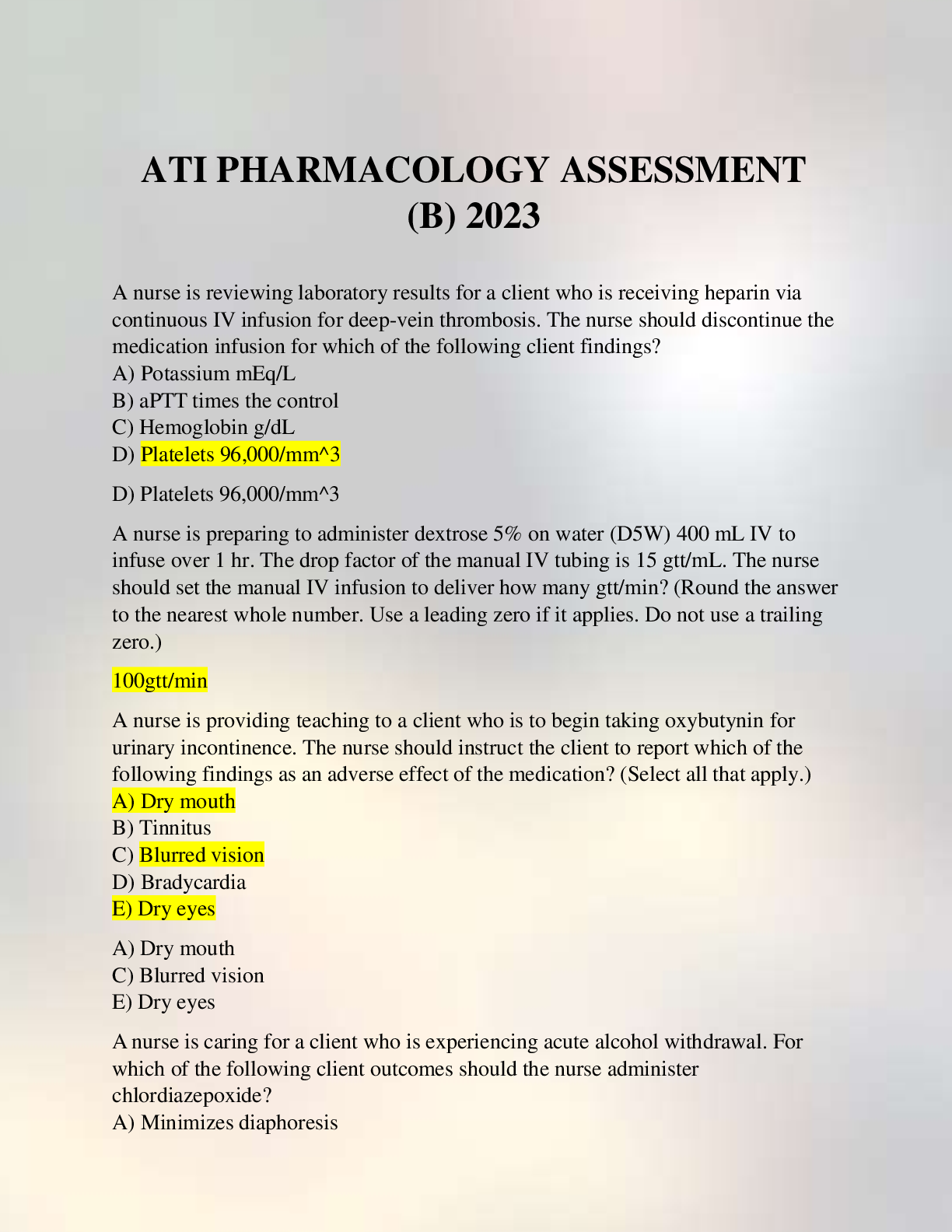*NURSING > EXAM REVIEW > Assessment RN VATI Adult Medical Surgical 2016,correct answers download today (All)
Assessment RN VATI Adult Medical Surgical 2016,correct answers download today
Document Content and Description Below
1. Inspect the client's skin underneath the boot every 12 hr. The nurse should inspect the client’s skin underneath the boot every 8 hr for irritation, increased swelling, and skin breakdown. ... Remove the weights from the traction while repositioning the client in bed. MY ANSWER The nurse should not remove the weights from traction without a prescription from the provider. The purpose of the weight is to immobilize the hip prior to surgery and to decrease muscles spasms. Assess the client's circulation every 4 hr. The nurse should assess the client's circulation hourly for the first 24 hr to monitor for decreased perfusion and neurovascular changes. Request the client to perform dorsiflexion of the affected extremity every 1 hr. The nurse should request the client to perform dorsiflexion of the affected extremity every 1 hr to assess if the client is experiencing nerve damage. Weakness of dorsiflexion can indicate peroneal nerve damage. If this occurs, the nurse should notify the provider immediately. 2. Stop the blood transfusion immediately. A client who has type AB-positive blood is considered a universal recipient and can receive any ABO blood type. A client who has Rh-positive blood can receive a transfusion from a Rh-negative donor. Prepare to administer antipyretics. Febrile reactions are most often caused by leukocyte incompatibilities. Unless a client has a history of febrile reactions to prior transfusions or shows signs of chills or fever, there is no reason to administer antipyretics. Monitor the client for any adverse reactions. MY ANSWER Although a client is considered a universal recipient because he can receive any ABO blood type, the nurse should continue to monitor the client for any adverse reactions, which is standard procedure for any blood transfusion. Transfuse the blood over 6 hr. The nurse should transfuse the packed RBCs within 4 hr after removing it from refrigeration to reduce the risk of bacterial contamination of the blood. 3. Assess the client to determine the need for endotracheal suction every 4 hr. Evidence-based practice indicates the nurse should assess the client's need for endotracheal suction every 2 hr to ensure a clear airway. Check the ventilator settings every 12 hr. Evidence-based practice indicates the nurse should check the ventilator settings every 8 hr to make sure the settings are at the correct levels. Keep the head of the client's bed elevated 30°. MY ANSWER The nurse should keep the head of the client's bed elevated at least 30° to promote increased lung expansion and to help prevent ventilator-associated pneumonia. Perform oral hygiene with chlorhexidine every 3 hr. Evidence-based practice indicates the nurse should perform oral hygiene with chlorhexidine every 2 hr to help prevent ventilator-associated pneumonia from bacteria accumulating in the oral cavity and colonizing in the lower respiratory system. 4. High lipase A high lipase level is associated with pancreatic dysfunction or renal failure and is not an expected finding of hyponatremia or dehydration. Low urine specific gravity MY ANSWER A client who has hyponatremia as a result of diuretic overuse will have a low urine specific gravity. The increased excretion of water alters the ratio of particulate matter, which affects the specific gravity. Low hemoglobin A client who is dehydrated as a result of diuretic overuse can have an elevated hemoglobin level because of the difference in ratio between intravascular fluid and blood cells. High creatine kinase-MB (CK-MB) An elevated CK-MB level indicates a myocardial infarction has occurred and is not an expected finding of hyponatremia. 5. "I will adjust the rate of infusion based on my urinary output." The nurse should teach the client to monitor urinary output. However, the client should administer PN at a consistent rate prescribed by the provider. An infusion rate that is too rapid can cause hyperosmolar diuresis and hyperglycemia. A rate that is too slow can result in inadequate caloric and nutritional intake. "I will need to have a 60-milliliter syringe to administer my PN." The nurse should teach the client to use an electronic infusion device to prevent the accidental overload of the intravenous PN solution. A 60-mL syringe is used for intermittent bolus enteral tube feedings. "I will keep additional solution bags at room temperature." The nurse should teach the client to refrigerate any PN solution that is not infusing to decrease the risk of bacterial growth. PN solution is an ideal environment for bacterial growth because of the high dextrose and fat content. "I will use aseptic technique when administering my PN." MY ANSWER The nurse should teach the client to use aseptic technique when connecting the infusion to the catheter hub to prevent microorganisms from entering the vascular system and causing a catheter-related bloodstream infection. 6. The stool will have a pasty texture. MY ANSWER The nurse should include in the teaching that stool with a pasty consistency is seen with a transverse colostomy. Over time, the drainage can become thicker as the body adapts to retain moisture. The stool will have a high volume of liquid. The nurse should include in the teaching that when peristalsis returns, a client can have an initial period of high-volume liquid stool output, up to 1,800 mL/day. Later, as the proximal small bowel adapts, stool volume should drop to about 800 mL/day. The stool will be solid and well-formed. The nurse should include in the teaching that solid stool is seen with a descending colostomy and is similar to stool that is evacuated from the rectum. Drainage from an ileostomy is not solid because it is not passing through the colon where a great deal of fluid is absorbed to form stool that is more solid i ...........................................................continued [Show More]
Last updated: 2 years ago
Preview 1 out of 37 pages

Buy this document to get the full access instantly
Instant Download Access after purchase
Buy NowInstant download
We Accept:

Reviews( 0 )
$14.50
Can't find what you want? Try our AI powered Search
Document information
Connected school, study & course
About the document
Uploaded On
Jul 17, 2021
Number of pages
37
Written in
Additional information
This document has been written for:
Uploaded
Jul 17, 2021
Downloads
0
Views
81










